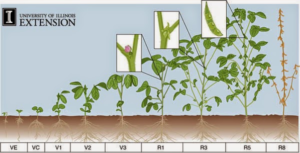We’ve all seen plenty of soybean fields this year and in the past where the soybeans have a burnt appearance. I thought I would dig into this topic a little more to give you an idea of what is going on. Injury symptoms on soybeans that include bronzing, speckling and give soybeans a “burnt” appearance are generally due to the PPO class of herbicides. Common products that make up this class are Flexstar, Cobra, Blazer, Cadet, and Resource to name a few. Many producers use Cobra as a tool for fighting white mold but that is a complex topic that can wait for another day. This article will focus solely on using PPO herbicides for weed control purposes. A huge topic of discussion in agriculture today is herbicide resistant weeds particularly to the active ingredient glyphosate, more commonly known as Roundup. Herbicide resistance has received a lot of press recently so what I want to focus on is weed control, crop injury and how their relationship affects yield.
Soybeans are an amazing plant due to their ability to recover from stresses with little yield loss which is the reason that we can spray them with herbicides that cause crop injury. When PPO herbicides are applied to susceptible plants, they cause a buildup of specific toxins in plant cells that can be lethal to certain plants and non-lethal to others like soybeans. Growing conditions and crop growth stage are important to think about when considering yield loss potential. Crop injury during stressful situations like cold, wet weather or hot, dry weather have a higher chance of reducing yield as opposed to when the injury happens during ideal growing conditions. Under optimal temperature and soil moisture, crop injury from herbicides labeled for soybeans have a very low probability of causing yield loss as the soybean plants can quickly grow new leaf tissue. Soybean growth stages are divided into two categories. Soybeans enter their reproductive (R) growth stages when flowering begins. Before that, their growth stages are referred to as vegetative (V). I’ve attached a chart since it’s hard to explain in print. Leaf defoliation during the vegetative stages causes little to no yield loss but can start to have an effect on yield once a soybean starts reproduction. This is where we can utilize our PPO herbicides for effective weed control. Weed control during the development of the first few trifoliate leaves (V1-V3) is critical for protecting yield. With this logic, it allows us to confidently use PPO herbicides when we are presented with situations involving weeds that are difficult to control with just glyphosate like Lambsquarter or glyphosate resistant weeds like Waterhemp. If you have questions about your herbicide program, contact your agronomist at WS Ag to start the conversation.


-Mark Kendall